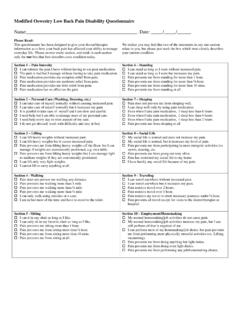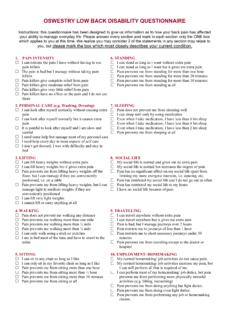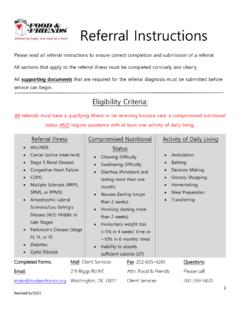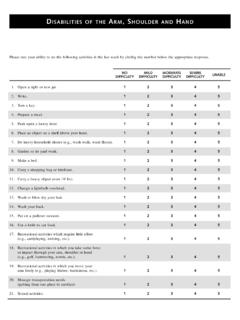Transcription of Palliative Performance Scale (PPSv2)
1 Palliative Performance Scale ( ppsv2 ). PPS Activity Level & Evidence of Ambulation Self -care Intake Conscious level Level Disease Normal activity & work PPS 100% Full Full Normal Full No evidence of disease Normal activity & work PPS 90% Full Full Normal Full Some evidence of disease Normal activity & work with effort PPS 80% Full Full Normal or reduced Full Some evidence of disease Unable normal activity & work PPS 70% Reduced Full Normal or reduced Full Significant disease Unable hobby/house work Occasional PPS 60% Reduced Normal
2 Or reduced Full or confusion Significant disease assistance Unable to do any work Considerable Full or drowsy or PPS 50% Mainly sit/lie Normal or reduced Extensive disease assistance confusion Unable to do most activity Mainly Full or drowsy PPS 40% Mainly in bed Normal or reduced Extensive disease assistance +/- confusion Unable to do any activity Full or drowsy PPS 30% Totally bed bound Total care Reduced Extensive disease +/- confusion Unable to do any activity Full or drowsy PPS 20% Totally bed bound Total care Minimal sips Extensive disease +/- confusion Unable to do any activity PPS 10% Totally bed bound Total care Mouth care only Drowsy or coma Extensive disease PPS 0% Dead - - - - Instructions: PPS level is determined by reading left to right to find a best horizontal fit.
3 ' Begin at left column reading downwards until current ambulation is determined, then, read across to next and downwards until each column is determined. Thus, leftward' columns take precedence over rightward' columns. Also, see definitions of terms' below. Definition of Terms for PPS. As noted below, some of the terms have similar meanings with the differences 3. Self-Care being more readily apparent as one reads horizontally across each row to find an Full Able to do all normal activities such as transfer out of bed, walk, overall best fit' using all five columns.
4 Wash, toilet and eat without assistance. Occasional assistance Requires minor assistance from several times a 1. Ambulation (Use item Self-Care to help decide the level) week to once every day, for the activities noted above. Full no restrictions or assistance Considerable assistance Requires moderate assistance every day, for Reduced ambulation degree to which the patient can walk and some of the activities noted above (getting to the bathroom, cutting up transfer with occasional assistance food, etc.)
5 Mainly sit/lie vs Mainly in bed the amount of time that the patient Mainly assistance Requires major assistance every day, for most of is able to sit up or needs to lie down the activities noted above (getting up, washing face and shaving, etc.). Totally bed bound unable to get out of bed or do self-care Can usually eat with minimal or no help. This may fluctuate with level of fatigue. 2. Activity & Evidence of Disease (Use Ambulation to help decide the level.) Total care Always requires assistance for all care.
6 May or may not be Activity Refers to normal activities linked to daily routines (ADL), able to chew and swallow food. house work and hobbies/leisure. Job/work Refers to normal activities linked to both paid and unpaid 4. Intake work, including homemaking and volunteer activities. Normal eats normal amounts of food for the individual as when Both include cases in which a patient continues the activity but may healthy reduce either the time or effort involved. Normal or reduced highly variable for the individual; reduced' means intake is less than normal amounts when healthy Evidence of Disease Minimal to sips very small amounts, usually pureed or liquid, and well No evidence of disease Individual is normal and healthy with no below normal intake.
7 Physical or investigative evidence of disease. Mouth care only no oral intake Some,' significant,' and extensive' disease Refers to physical or investigative evidence which shows disease progression, sometimes 5. Conscious Level despite active treatments. Full fully alert and orientated, with normal (for the patient) cognitive abilities (thinking, memory, etc. ). Example 1: Breast cancer: Full or confusion level of consciousness is full or may be reduced. If some = a local recurrence reduced, confusion denotes delirium or dementia which may be mild, significant = one or two metastases in the lung or bone moderate or severe, with multiple possible etiologies.
8 Extensive = multiple metastases (lung, bone, liver or brain), Full or drowsy +/- confusion level of consciousness is full or may be hypercalcemia or other complication markedly reduced; sometimes included in the term stupor. Implies Example 2: CHF: fatigue, drug side effects, delirium or closeness to death. some = regular use of diuretic &/or ACE inhibitors to control Drowsy or coma +/- confusion no response to verbal or physical significant = exacerbations of CHF, effusion or edema necessitating stimuli; some reflexes may or may not remain.
9 The depth of coma may increases or changes in drug management fluctuate throughout a 24 hour period. Usually indicates imminent death extensive = 1 or more hospital admissions in past 12 months for acute CHF & general decline with effusions, edema, SOB.







